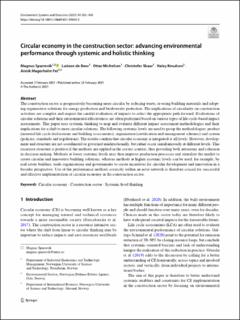| dc.contributor.author | Sparrevik, Magnus | |
| dc.contributor.author | De Boer, Luitzen | |
| dc.contributor.author | Michelsen, Ottar | |
| dc.contributor.author | Skaar, Christofer | |
| dc.contributor.author | Knudson, Haley | |
| dc.contributor.author | Fet, Annik Magerholm | |
| dc.date.accessioned | 2021-09-27T07:27:59Z | |
| dc.date.available | 2021-09-27T07:27:59Z | |
| dc.date.created | 2021-02-23T12:15:36Z | |
| dc.date.issued | 2021 | |
| dc.identifier.citation | Environment Systems and Decisions. 2021, 41 (3), 392-400. | en_US |
| dc.identifier.issn | 2194-5403 | |
| dc.identifier.uri | https://hdl.handle.net/11250/2783592 | |
| dc.description.abstract | The construction sector is progressively becoming more circular by reducing waste, re-using building materials and adopting regenerative solutions for energy production and biodiversity protection. The implications of circularity on construction activities are complex and require the careful evaluation of impacts to select the appropriate path forward. Evaluations of circular solutions and their environmental efectiveness are often performed based on various types of life cycle-based impact assessments. This paper uses systemic thinking to map and evaluate diferent impact assessment methodologies and their implications for a shift to more circular solutions. The following systemic levels are used to group the methodologies: product (material life cycle declarations and building assessments), organisation (certifcation and management schemes) and system (policies, standards and regulations). The results confrm that circular economy is integrated at all levels. However, development and structure are not coordinated or governed unidirectionally, but rather occur simultaneously at diferent levels. This recursive structure is positive if the methods are applied in the correct context, thus providing both autonomy and cohesion in decision making. Methods at lower systemic levels may then improve production processes and stimulate the market to create circular and innovative building solutions, whereas methods at higher systemic levels can be used, for example, by real estate builders, trade organisations and governments to create incentives for circular development and innovation in a broader perspective. Use of the performance methods correctly within an actor network is therefore crucial for successful and efective implementation of circular economy in the construction sector. | en_US |
| dc.language.iso | eng | en_US |
| dc.publisher | Springer | en_US |
| dc.relation.uri | http://link.springer.com/article/10.1007/s10669-021-09803-5 | |
| dc.rights | Navngivelse 4.0 Internasjonal | * |
| dc.rights.uri | http://creativecommons.org/licenses/by/4.0/deed.no | * |
| dc.title | Circular economy in the construction sector: advancing environmental performance through systemic and holistic thinking | en_US |
| dc.type | Journal article | en_US |
| dc.type | Peer reviewed | en_US |
| dc.description.version | publishedVersion | en_US |
| dc.source.pagenumber | 392-400 | en_US |
| dc.source.volume | 41 | en_US |
| dc.source.journal | Environment Systems and Decisions | en_US |
| dc.source.issue | 3 | en_US |
| dc.identifier.doi | 10.1007/s10669-021-09803-5 | |
| dc.identifier.cristin | 1892708 | |
| cristin.ispublished | true | |
| cristin.fulltext | original | |
| cristin.qualitycode | 1 | |

